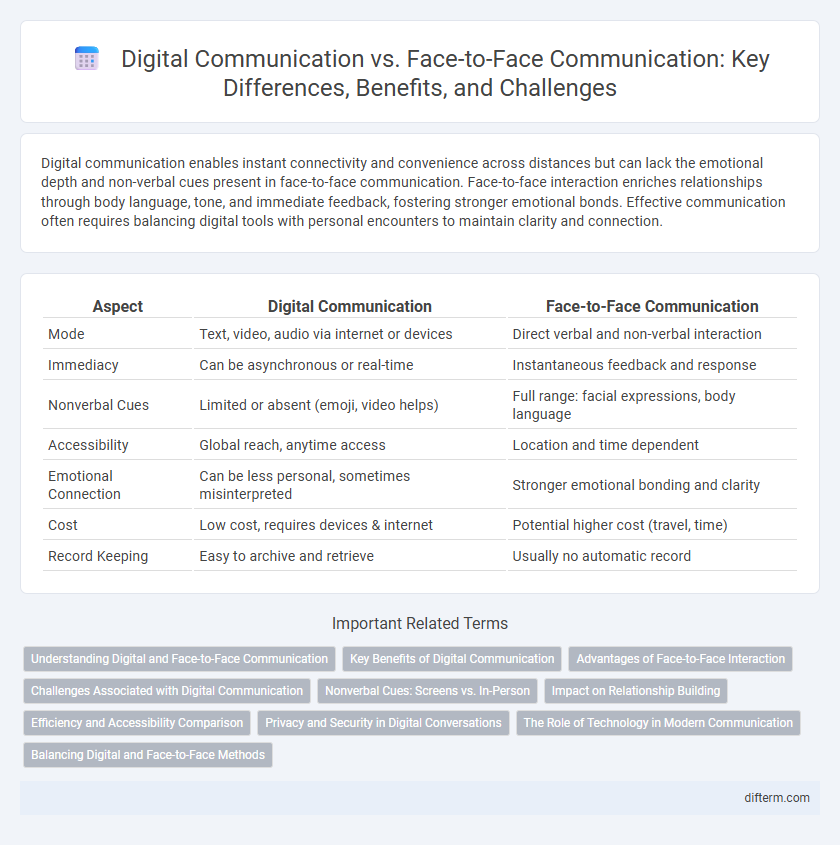Digital communication enables instant connectivity and convenience across distances but can lack the emotional depth and non-verbal cues present in face-to-face communication. Face-to-face interaction enriches relationships through body language, tone, and immediate feedback, fostering stronger emotional bonds. Effective communication often requires balancing digital tools with personal encounters to maintain clarity and connection.
Table of Comparison
| Aspect | Digital Communication | Face-to-Face Communication |
|---|---|---|
| Mode | Text, video, audio via internet or devices | Direct verbal and non-verbal interaction |
| Immediacy | Can be asynchronous or real-time | Instantaneous feedback and response |
| Nonverbal Cues | Limited or absent (emoji, video helps) | Full range: facial expressions, body language |
| Accessibility | Global reach, anytime access | Location and time dependent |
| Emotional Connection | Can be less personal, sometimes misinterpreted | Stronger emotional bonding and clarity |
| Cost | Low cost, requires devices & internet | Potential higher cost (travel, time) |
| Record Keeping | Easy to archive and retrieve | Usually no automatic record |
Understanding Digital and Face-to-Face Communication
Digital communication enables rapid information exchange through text, video, and multimedia platforms, supporting global connectivity and asynchronous interaction. Face-to-face communication offers immediate feedback, nonverbal cues, and emotional expression, which enhance understanding and relationship-building. Balancing both methods improves overall communication effectiveness by leveraging digital convenience alongside personal interaction.
Key Benefits of Digital Communication
Digital communication offers unparalleled speed and accessibility, enabling instant interaction across global distances through tools like email, messaging apps, and video conferencing platforms. It supports asynchronous communication, allowing users to send and respond to messages at their convenience, enhancing productivity and flexibility. Advanced digital communication also facilitates multimedia sharing and real-time collaboration, driving efficiency in both professional and personal contexts.
Advantages of Face-to-Face Interaction
Face-to-face communication enhances non-verbal cues such as body language and facial expressions, fostering deeper emotional connections and reducing misunderstandings. It supports immediate feedback and spontaneous dialogue, which strengthens trust and collaboration among individuals. This mode of interaction also improves relational bonds by creating a more authentic and engaging communication experience.
Challenges Associated with Digital Communication
Digital communication often faces challenges such as misinterpretation of tone and intent due to the absence of nonverbal cues like facial expressions and body language. Technical issues, including connectivity problems and platform inconsistencies, can disrupt message delivery and reduce interaction quality. Privacy concerns and information security risks also pose significant obstacles in digital communication environments.
Nonverbal Cues: Screens vs. In-Person
Nonverbal cues in digital communication are often limited to facial expressions and tone of voice visible through screens, which can reduce the richness of interactions compared to in-person communication. Face-to-face communication allows for a full range of body language, gestures, and eye contact, enhancing emotional understanding and connection. The absence of these nonverbal signals in digital communication can lead to misunderstandings and decreased empathy.
Impact on Relationship Building
Digital communication enables instant connectivity across distances, fostering relationships through frequent interactions and diverse multimedia exchanges. Face-to-face communication, however, offers richer emotional cues like body language and tone, which deepen trust and empathy essential for strong relationship building. Combining both methods can enhance relationship development by balancing immediacy with meaningful personal connection.
Efficiency and Accessibility Comparison
Digital communication offers unmatched efficiency by enabling instantaneous message delivery across global distances, reducing time delays inherent in face-to-face interactions. Accessibility is significantly enhanced through digital platforms, allowing users with diverse physical abilities or geographic constraints to engage in conversations without the need for physical presence. Face-to-face communication, while rich in non-verbal cues, often requires greater time and logistical coordination, making it less scalable for rapid or widespread information exchange.
Privacy and Security in Digital Conversations
Digital communication often raises significant privacy and security concerns due to data breaches, hacking risks, and unauthorized surveillance. Unlike face-to-face conversations, digital interactions rely heavily on encryption protocols like end-to-end encryption to protect sensitive information. Users should prioritize platforms with robust security measures such as two-factor authentication and secure data storage to safeguard their digital conversations.
The Role of Technology in Modern Communication
Technology plays a crucial role in modern communication by enabling instant connectivity through digital platforms such as email, social media, and video conferencing. These tools facilitate global interactions, reducing geographical barriers while enhancing the speed and accessibility of information exchange. Despite the convenience of digital communication, face-to-face interactions remain essential for interpreting non-verbal cues and fostering deeper emotional connections.
Balancing Digital and Face-to-Face Methods
Balancing digital and face-to-face communication methods enhances clarity and emotional connection in interactions, leveraging the convenience of digital tools while preserving the nuanced understanding achieved through in-person exchanges. Prioritizing face-to-face communication in complex or sensitive discussions reduces misinterpretations and builds stronger interpersonal relationships. Integrating video calls, instant messaging, and in-person meetings creates a dynamic communication strategy that optimizes engagement and productivity across diverse contexts.
digital communication vs face-to-face communication Infographic

 difterm.com
difterm.com